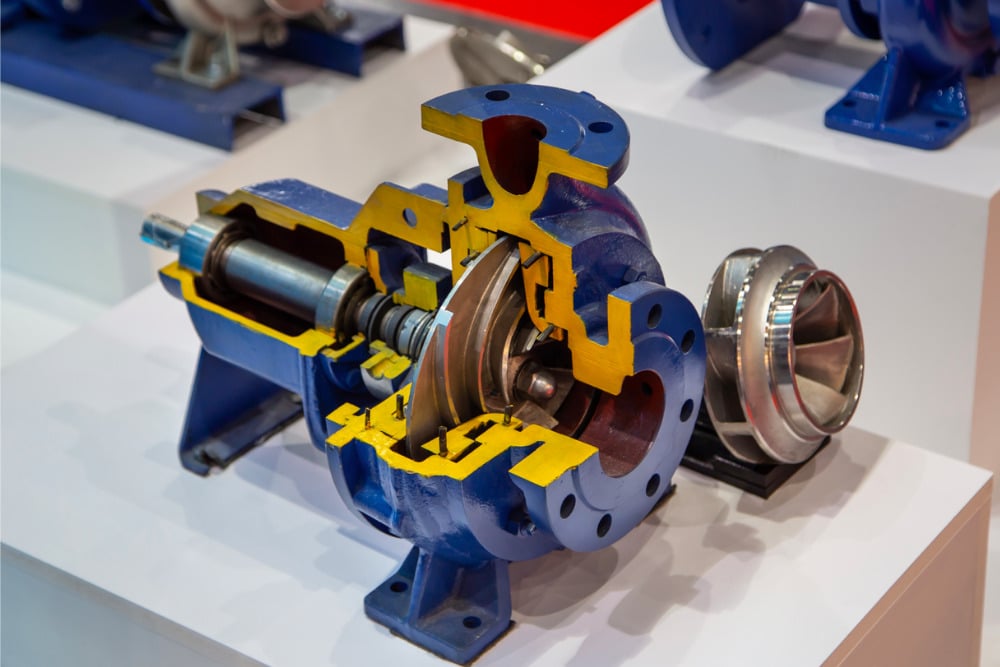The most important part of any screw air compressor is the compressor element. The compressor element is often also called the air end. This element comprises various components to ensure the efficiency of the screw air compressor, and the components will be explained below.
Screws/Rotors
The screws or rotors are a critical part of the screw air compressor or industrial air compressor parts and a fundamental part of the entire compression process. These screws come in pairs (male and female rotors) and are located inside cylinders, where rotations occur. When the air compressor is turned on, the screws rotate at high speed to create a ‘ chamber’ through which air drawn from the atmosphere will move. The air is compressed and discharged.
Compression Cylinders
Compression cylinders are a central part of screw air compressors. The air sucked in passes through the cylinder chambers and reached the rotating screws. A screw air compressor can be single or two-stage, which can determine the number of cylinders the machine has and the amount of pressurization it can produce. Cast iron and steel are the most common materials in which this cylinder is manufactured.
Air Filters
The inlet air filter is located just inside the opening valve of the screw air compressor. The air filter minimizes damage to the interior of the screw compressor by counteracting dust, moisture, and air particles. Other air filters could also be used as additional cleaning and protection by placing them inside the chamber parts. Please note the location of this air filter to ensure you receive the freshest, cleanest air possible.
Oil Filters
The oil filter works to both clean and maintain the purity of the compressed air. To ensure that oil lubrication is adequately screened from the compressed air in oil-injected rotary screw compressors, the oil filter is placed within the walls of the rotating chamber and near the discharge valves. Screw air compressors can produce a lot of heat, but oil lubrication can provide the cooling needed to keep the compressor operating safely. Most oil filters are also installed with bypass valves.
Oil Cooler
Screw compressor air from Fluid-Aire Dynamics for example can generate a lot of heat. The compressor oil, used to seal the rotors, lubricate, and cool, passes through the cooler before passing through the compressor element again. Fresh, clean air in the cooler is required to keep the oil in that optimal temperature range.
Bearings
To ensure that the screws are secure and rotate evenly, bearings are placed at both ends of the screws. Other bearings are installed in key locations in the screw air compressor, but the most important are the radial load bearings and the axial bearings.
There are a variety of design modifications when it comes to bearings, which depend on the size and expectations of your screw air compressor, and whether the compressor is oil-lubricated or non-oil-lubricated. However, the bearings are generally anti-friction and anti-corrosion.
Hoses
Hoses are needed in rotary screw air compressor systems when components are in different locations, and oil and air must move between them. Heat and pressure requirements should be considered when finding a hose for your rotary screw compressor system. They should be placed away from any hot or sharp components to protect the hose from damage.
Suction Valve
Most screw air compressors have a suction valve on the top. This suction valve will open when necessary to allow air to enter and be trapped within the two rotating screws.
The three main types of suction valves are the seat, plate, and ring valves. Each consists of different shapes to create the ideal airflow for types of operation.
Discharge valve
The discharge valves are located at the opposite end of the suction valve to complete the compression cycle. The air that has now been pressurized is received by the discharge valve to be released into a storage tank or discharge pipe for immediate application.
The discharge valve acts as a critical regulating agent, and if it does not function correctly, you risk causing damage to your machine, personnel near the compressor, or your immediate work environment.
Engine
A screw air compressor requires a reliable motor as the use of these compressors is usually on a large scale. Most motors will be powered by electrical power.
The screw air compressor motor drives the rotation of the screws and the entire compressor. To ensure the safety of your compressor, motors on newer machines can be monitored with intelligent control systems.
Control System
With a control system, the operator can monitor the status of the screw air compressors and the overall performance of the compressed air system. The control system will regulate the different parts of the compressor and the operation parameters, start or stop of the compressors. This system allows for safe monitoring of your screw air compressor.
Tanks
Generally, screw air compressors will come with a compressor storage tank which can vary in size depending on the application. Pressurized air is received from the discharge valve to the storage tank. The air is safely in the storage tank and maintains pressure until use.
Oil Separators
Oil separator tanks act as a defense mechanism against oil and gas mixtures in oil-lubricated screw air compressors. In oil-lubricated screw air compressors, it is important to filter and clean excess oil from the newly compressed air.
An oil separator will ensure that little or no oil residue is found in the compressed air.
